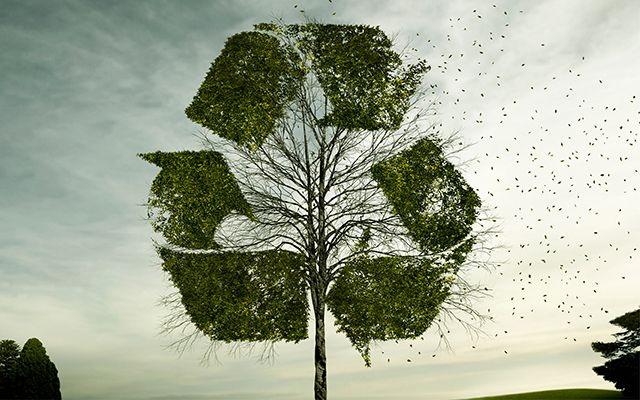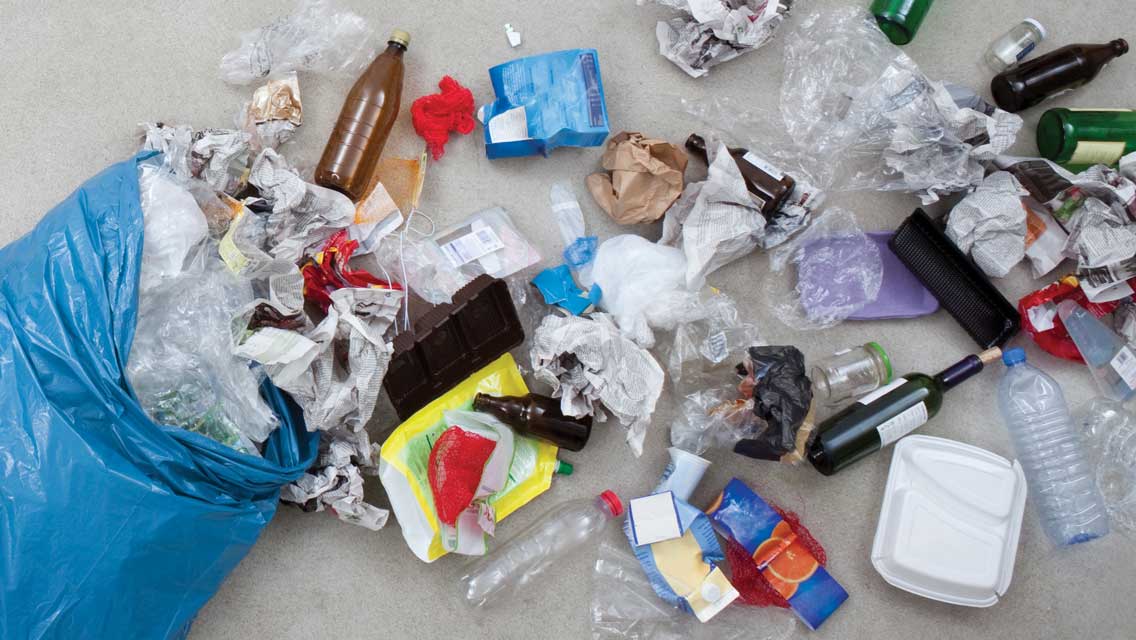They paved paradise and put up a parking lot,” quipped legendary singer and songwriter Joni Mitchell. Since 1970, when Mitchell released her song “Big Yellow Taxi,” the concrete jungle has expanded.
More than half of the world’s population now lives in cities, a number that’s expected to grow to 68 percent by 2050. Cities, in turn, need more homes, offices, bridges, and sidewalks. Because of its durability, concrete has become the foundation of human-made development; after water, it’s the most widely used substance on Earth.
Though concrete’s strength has cemented its use in building, it has substantial environmental drawbacks. The production of cement — an essential ingredient in concrete —accounts for about 7 percent of global energy use, 7 percent of global carbon dioxide emissions, and a tenth of the world’s industrial water use.
Further, waterproofing sealants added to concrete make it nonporous, leading to surface runoff that contributes to water pollution, soil erosion, and flooding.
To mitigate these issues, manufacturers are experimenting with greener production methods, and urban planners and policymakers are seeking ways to soften the urban jungle and improve human health.
Cooling Down Tinseltown
Access to the ocean and ample sunshine attract a lot of people to Los Angeles — so much so that it’s become the second most populous city in the United States.
Like most major metropolises, though, L.A. is home to miles and miles of asphalt, pavement that traps heat and adds to the urban heat-island effect (when air temperatures spike several degrees higher than surrounding vegetated areas). In an effort to make the City of Angels cooler, officials have been experimenting with CoolSeal, a light-gray, water-based coating. After being applied to parking lots and a handful of public roads, it has reduced the heat gain by up to 10 degrees F.
These are significant results, “particularly when you’re talking about asphalt that gets up to 130, 140 degrees,” says Matt Peterson, the city’s chief sustainability officer.
The lower temperatures could spell relief for the city’s poorest residents, who tend to live in the hottest parts of town. Heat can damage air quality by accelerating chemical reactions, which can exacerbate chronic health conditions, including asthma and heart disease; this disproportionately affects people living in poverty.
Researchers warn that CoolSeal’s own environmental impacts haven’t been fully studied. And installation costs — between $25,000 and $40,000 per mile for a life of five to seven years — make it a significant financial investment. But residents like Maria Jimenez say they already feel the difference. “If it wasn’t for this street,” she notes, “the heat wave would make my apartment hotter.”
Greening Passageways
Americans, on average, spend only about 5 percent of their time outside. But studies have found that access to green space improves health and well-being. For example, exposure to nature has been linked to reduced stress and improved mood.
Other research suggests that people living in higher-income neighborhoods with parks and large front yards are healthier than those who live in multifamily dwellings in densely populated areas.
To close this health and “green-space gap,” cities are planting trees, turning parking lots into parks, creating pocket parks (replacing several parking spaces with planters, shrubs, benches, and café tables), and changing zoning laws to allow more community and asphalt gardens (building planters on top of concrete).
Some municipalities, such as Nashville and Montreal, are also reimagining the traditional alleyway, typically used for local car traffic and garbage pickup.
Montreal’s Ruelles Vertes (Green Alleyways) program has turned more than 250 blocks of alleys into gardens, play spaces, and gathering spots.
In addition to strengthening community, renaturalization helps mitigate the effects of climate change.
When record flooding hit Nashville in 2010, policymakers looked for new ways to handle the water influx. In 2015 the city partnered with local nonprofits to plant 150 rain gardens in neighborhood alleys. These small depressions were filled with amended soil and groups of plants and shrubs that tolerate wetter conditions and work together to absorb rainwater and filter out pollutants.
“Beyond stormwater capturing, I see wildlife habitat and aesthetic sense of place [for people] as the real benefits,” says Will Caplenor, program manager of Cumberland River Compact, one of the city’s partners.
Curbing Rising Tides
Hurricanes are becoming more frequent (the 2018 season was one of the most active on record, with 22 major hurricanes in the Northern Hemisphere in less than three months) and their devastating floodwaters have sparked urban-design changes in coastal cities.
“The price of climate change in loss of life and property is paid locally,” says the Trust for Public Land’s director of climate, Brendan Shane. “That’s why local action on climate tends to come from a more bipartisan group than at the national level.”
Houston, which is regularly hit hard by hurricanes, features many neighborhoods built on floodplains. “Flooding from Hurricane Harvey [in 2017] was absolutely devastating for the Houston community. While the amount of rain was unprecedented, the flooding was exacerbated by Houston’s dense development,” says Laura Huffman, the Nature Conservancy’s regional director in Texas.
To ease the density, the city is working on a project called Bayou Greenways 2020 that would create a 150-mile network of parks and trails. It’s also focused on improving drainage and building detention ponds to capture stormwater.
A 2019 Nature Conservancy study found that buying strategic clusters of flood-damaged properties and converting the parcels into green space would save more money than installing additional infrastructure, such as pipes — while providing ecological and social benefits.
A city with lots to lose as climate change accelerates, New York adopted an innovative zoning-code amendment in 2007 that requires new parking areas to include planted spots, and the city has since experimented with using porous asphalt and bioinfiltration swales — depressions that can hold water runoff from storms.
After Hurricane Sandy hit the Northeast coast in 2012, the Big Apple ramped up its flood resiliency by developing and renovating waterfront parks to better absorb and drain rainwater.
Atlanta is poised to complete its own 16-acre “water-smart” park designed to sop up millions of gallons in a flood-prone neighborhood. Featuring an outdoor classroom and rock-climbing wall, Cook Park will provide residents who lack access to many other green spaces with room to play and connect with nature and one another.
“The stronger the bonds are from neighbor to neighbor,” says Shane, “the better they are able to react to a shock.”
This article originally appeared as “Kicking Asphalt” in the April 2020.




This Post Has 0 Comments